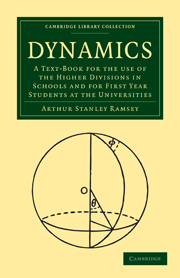 Dynamics
Dynamics Published online by Cambridge University Press: 07 September 2010
1·1. The subject of Dynamics is generally divided into two branches: the first, called Kinematics, is concerned with the geometry of motion apart from all considerations of force, mass or energy; the second, called Kinetics, is concerned with the effects of forces on the motion of bodies.
1·2. In order to describe the motion of a body or of a point two things are needed, (i) a frame of reference, (ii) a time-keeper. It is not possible to describe absolute motion, but only motion relative to surrounding objects; and a suitable frame of reference depends on the kind of motion that it is desired to describe. Thus if the motion is rectilinear the distance from a fixed point on the line is a sufficient description of the position of the moving point; and in more general cases systems of two or of three rectangular axes may be chosen as a frame of reference. For example, in the case of a body projected from the surface of the Earth a set of axes with the origin at the point of projection would be suitable for the description of motion relative to the Earth. But, for the description of the motion of the planets, it would be more convenient to take a frame of axes with an origin at the Sun's centre.
1·3. It is important to realize that there is no such thing as absolute time, but the period of rotation of the Earth relative to the fixed stars provides a unit of time, the sidereal day, which, so far as it can be tested with other time measures, is constant and therefore adequate for the purposes of ordinary dynamics.
To save this book to your Kindle, first ensure [email protected] is added to your Approved Personal Document E-mail List under your Personal Document Settings on the Manage Your Content and Devices page of your Amazon account. Then enter the ‘name’ part of your Kindle email address below. Find out more about saving to your Kindle.
Note you can select to save to either the @free.kindle.com or @kindle.com variations. ‘@free.kindle.com’ emails are free but can only be saved to your device when it is connected to wi-fi. ‘@kindle.com’ emails can be delivered even when you are not connected to wi-fi, but note that service fees apply.
Find out more about the Kindle Personal Document Service.
To save content items to your account, please confirm that you agree to abide by our usage policies. If this is the first time you use this feature, you will be asked to authorise Cambridge Core to connect with your account. Find out more about saving content to Dropbox.
To save content items to your account, please confirm that you agree to abide by our usage policies. If this is the first time you use this feature, you will be asked to authorise Cambridge Core to connect with your account. Find out more about saving content to Google Drive.